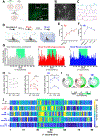A Ventromedial Prefrontal-to-Lateral Entorhinal Cortex Pathway Modulates the Gain of Behavioral Responding During Threat
- PMID: 36925415
- PMCID: PMC10354215
- DOI: 10.1016/j.biopsych.2023.01.009
A Ventromedial Prefrontal-to-Lateral Entorhinal Cortex Pathway Modulates the Gain of Behavioral Responding During Threat
Abstract
Background: The ability to correctly associate cues and contexts with threat is critical for survival, and the inability to do so can result in threat-related disorders such as posttraumatic stress disorder. The prefrontal cortex (PFC) and hippocampus are well known to play critical roles in cued and contextual threat memory processing. However, the circuits that mediate prefrontal-hippocampal modulation of context discrimination during cued threat processing are less understood. Here, we demonstrate the role of a previously unexplored projection from the ventromedial region of PFC (vmPFC) to the lateral entorhinal cortex (LEC) in modulating the gain of behavior in response to contextual information during threat retrieval and encoding.
Methods: We used optogenetics followed by in vivo calcium imaging in male C57/B6J mice to manipulate and monitor vmPFC-LEC activity in response to threat-associated cues in different contexts. We then investigated the inputs to, and outputs from, vmPFC-LEC cells using Rabies tracing and channelrhodopsin-assisted electrophysiology.
Results: vmPFC-LEC cells flexibly and bidirectionally shaped behavior during threat expression, shaping sensitivity to contextual information to increase or decrease the gain of behavioral output in response to a threatening or neutral context, respectively.
Conclusions: Glutamatergic vmPFC-LEC cells are key players in behavioral gain control in response to contextual information during threat processing and may provide a future target for intervention in threat-based disorders.
Keywords: Gain modulation; Lateral entorhinal; Prefrontal; Threat encoding; Threat retrieval.
Copyright © 2023 Society of Biological Psychiatry. Published by Elsevier Inc. All rights reserved.
Conflict of interest statement
Figures






Comment in
-
Contextualizing a Prefrontal-to-Lateral Entorhinal Cortex Circuit Mediating Fear Expression.Biol Psychiatry. 2023 Aug 1;94(3):e11-e13. doi: 10.1016/j.biopsych.2023.05.011. Biol Psychiatry. 2023. PMID: 37437991 No abstract available.
References
-
- Sierra-Mercado D, Corcoran KA, Lebrón-Milad K & Quirk GJ Inactivation of the ventromedial prefrontal cortex reduces expression of conditioned fear and impairs subsequent recall of extinction. European Journal of Neuroscience 24, 1751–1758 (2006). - PubMed
Publication types
MeSH terms
Substances
Grants and funding
LinkOut - more resources
Full Text Sources
Miscellaneous

